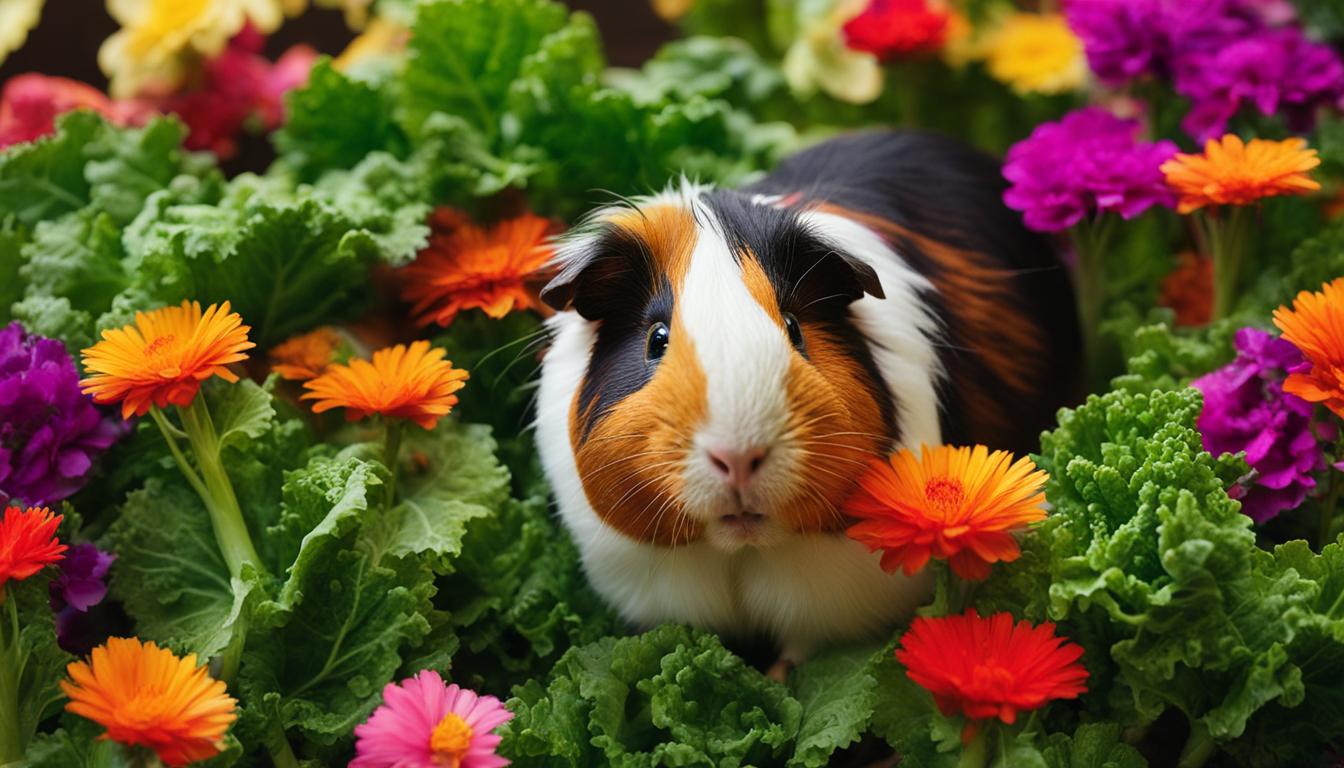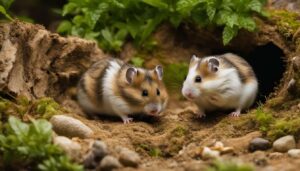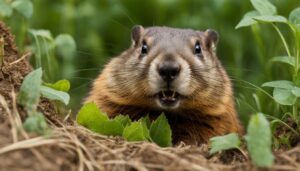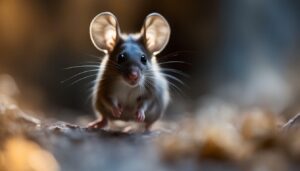Welcome to our comprehensive guide on feeding kale to guinea pigs! As responsible pet owners, we want to ensure that our furry friends receive a balanced and nutritious diet. So, let’s dive into the topic of kale and its suitability for guinea pigs.
Kale, a leafy green vegetable, is known for its high nutritional value. Packed with vitamins A, C, and K, as well as calcium and iron, kale offers various health benefits for guinea pigs.
But before we delve into the details, let’s address the burning question: Can guinea pigs eat kale?
Key Takeaways:
- Kale is a nutritious leafy green vegetable for guinea pigs.
- It is high in vitamins A, C, and K, calcium, and iron.
- Offer kale in moderation, typically no more than a handful per guinea pig per day.
- Include kale as part of a balanced diet that incorporates other vegetables, hay, and pellets.
- Consult with a veterinarian for personalized dietary guidance for your guinea pigs.
The Nutritional Benefits of Kale for Guinea Pigs
Kale is an incredibly nutritious vegetable that offers a range of health benefits for guinea pigs. It is packed with vitamins and minerals that are essential for their overall well-being. Here are some of the key nutritional benefits of kale for guinea pigs:
- Vitamins: Kale is rich in vitamins A, C, and K, which are crucial for maintaining healthy immune systems, promoting proper growth and development, and supporting overall health.
- Minerals: This leafy green vegetable is also a great source of important minerals such as calcium and iron. Calcium is essential for strong bones and teeth, while iron supports the production of healthy red blood cells.
- Fiber: Kale is high in dietary fiber, which aids in maintaining a healthy digestive system for guinea pigs. It helps regulate bowel movements and prevents gastrointestinal issues.
By incorporating kale into your guinea pig’s diet, you can provide them with these essential nutrients that contribute to their overall health and well-being. However, it’s important to remember that kale should be given in moderation, as excessive amounts can lead to digestive issues. It is recommended to offer a handful of kale per guinea pig per day as part of a balanced diet.
Remember to always wash the kale thoroughly before feeding it to your guinea pig to remove any potential harmful chemicals or pesticides. Additionally, it’s crucial to introduce kale gradually into their diet and monitor their response to ensure they tolerate it well. If you notice any digestive upset or other adverse reactions, consult with a veterinarian.
The Importance of Vitamin C for Guinea Pigs
Vitamin C is an essential nutrient for guinea pigs as they cannot produce it on their own. As luck would have it, kale is an excellent source of this important vitamin. Guinea pigs need vitamin C for several reasons, including:
- Preventing scurvy: A lack of vitamin C can lead to scurvy, a condition characterized by weakness, poor appetite, and joint pain. Including kale in their diet helps ensure they receive an adequate amount of vitamin C to prevent this.
- Boosting the immune system: Vitamin C plays a crucial role in strengthening the immune system, helping guinea pigs ward off illnesses and infections.
- Collagen production: Collagen, a protein responsible for maintaining healthy skin, bones, and blood vessels, relies on vitamin C for its production. Including kale in their diet can contribute to the production of collagen in guinea pigs.
While kale is a fantastic source of vitamin C, it’s important to provide a varied diet to guinea pigs to ensure they receive this nutrient from multiple sources. This is particularly important because guinea pigs cannot store vitamin C for long periods, and their bodies may quickly deplete their reserves. Fresh fruits and vegetables rich in vitamin C, along with high-quality commercial guinea pig pellets, can help ensure they meet their daily vitamin C requirements.
Incorporating Kale into Your Guinea Pig’s Diet
If you’re considering adding kale to your guinea pig’s diet, it’s important to do so in a way that ensures a balanced and varied meal plan. Here are some tips for incorporating kale into your guinea pig’s diet:
Mixing Kale with Other Vegetables
When feeding kale to your guinea pig, it’s best to mix it with other vegetables to provide a variety of nutrients. This helps prevent your guinea pig from getting bored with their food and ensures they receive a wide range of vitamins and minerals. Some vegetables that pair well with kale include bell peppers, lettuce, and celery. By combining different vegetables, you can create a colorful and enticing meal for your furry friend.
Serving Size of Kale for Guinea Pigs
While kale is a nutritious vegetable, it’s important not to overfeed it to your guinea pig. A small amount of kale, about the size of a handful, is sufficient for a single serving. This ensures that your guinea pig receives the benefits of kale without consuming excessive amounts of any one food. Remember, a balanced diet is key to your guinea pig’s health, so offering a variety of vegetables alongside kale is highly recommended.
Variety in Your Guinea Pig’s Diet
Just like humans, guinea pigs enjoy variety in their diet. Incorporating different vegetables, including kale, helps prevent nutritional deficiencies and keeps mealtime interesting for your pet. Rotate the vegetables you offer to provide a range of flavors and textures. This not only keeps your guinea pig’s taste buds happy, but also ensures they receive a wide array of nutrients essential for their well-being.
By following these guidelines, you can safely introduce kale into your guinea pig’s diet and provide them with a healthy and nutritious meal. Remember to always consult with a veterinarian for personalized dietary advice specific to your guinea pig’s needs.
Considerations When Feeding Kale to Guinea Pigs

When feeding kale to guinea pigs, there are several important considerations to keep in mind. Properly washing the kale before offering it to your furry friends is crucial to remove any harmful chemicals or pesticides that may be present. This ensures the safety and well-being of your guinea pigs.
It is also important to avoid feeding wilted or spoiled kale to your guinea pigs. These can harbor harmful bacteria or mold, which can be detrimental to their health. Always opt for fresh, crisp kale to provide them with the best nutrition.
Another consideration is the potential digestive problems that can arise from feeding guinea pigs too many high-protein vegetables. While kale is a nutritious leafy green, it is also high in protein. It should be given in moderation to prevent any digestive issues that may arise from an excessive protein intake.
Lastly, kale contains oxalates, which can contribute to the formation of bladder stones in guinea pigs if consumed in excess. It is important to offer a variety of vegetables in your guinea pigs’ diet to ensure they receive a well-rounded nutritional intake.
Considerations When Feeding Kale to Guinea Pigs:
| Consideration | Explanation |
|---|---|
| Washing Kale | Thoroughly wash kale to remove harmful chemicals and pesticides. |
| Avoiding Wilted or Spoiled Kale | Choose fresh, crisp kale to prevent the growth of harmful bacteria or mold. |
| High-Protein Vegetables | Moderate the intake of high-protein vegetables, including kale, to avoid digestive issues. |
| Oxalates in Kale | Offer a variety of vegetables to prevent excessive oxalate intake and potential bladder stone formation. |
The Importance of a Balanced Diet for Guinea Pigs
When it comes to the well-being of our furry friends, maintaining a balanced diet is essential. Guinea pigs, like humans, require a variety of nutrients to stay healthy and thrive. While kale provides important vitamins and minerals, it alone cannot fulfill all of a guinea pig’s dietary needs. A balanced diet not only prevents nutrient imbalances but also helps to avoid potential health problems that may arise from a kale-exclusive diet.
Varying your guinea pig’s diet is crucial to ensure they receive a wide range of nutrients. While kale can be part of their meal rotation, it should be mixed with other leafy greens such as carrot tops and romaine lettuce. These alternatives provide additional vitamins and minerals, including vitamin C, which is vital for guinea pigs as they cannot produce it on their own. By incorporating other vegetables into their diet, we can reduce the risk of nutrient deficiencies and promote overall health.
Other Leafy Greens for Guinea Pigs:
- Bell peppers: A great source of vitamin C
- Lettuce: Provides hydration and fiber
- Celery: Contains vitamins A, C, and K, as well as fiber
A balanced diet for guinea pigs should also include a good amount of fresh grass hay, which supports their digestive system and helps maintain healthy teeth. Pellets formulated specifically for guinea pigs can be added to their diet as a source of additional nutrients. By offering a variety of vegetables, hay, and pellets, we can ensure that our guinea pigs receive a well-rounded and nutritionally complete diet.
| Foods to Include in a Guinea Pig’s Balanced Diet | Foods to Limit or Avoid |
|---|---|
| Leafy greens (kale, carrot tops, romaine lettuce) | Dairy products |
| Bell peppers | High-sugar fruits (grapes, bananas) |
| Lettuce | Processed foods |
| Celery | Nuts and seeds |
| Fresh grass hay | Meat and animal products |
| Pellets formulated for guinea pigs | Human treats and snacks |
By ensuring a balanced diet for our guinea pigs, we can promote their overall health and well-being. Remember to consult with a veterinarian for specific dietary advice tailored to your guinea pig’s needs. With a well-rounded and varied diet, our furry friends can enjoy a happy and healthy life.
Washing and Handling Kale for Guinea Pigs

When it comes to feeding kale to your guinea pigs, proper washing and handling are essential to ensure their safety and well-being. To remove any harmful chemicals or pesticides, thoroughly wash the kale before serving it to your furry friends. This can be done by rinsing it under running water and gently rubbing the leaves to remove any dirt or residue.
It is also important to prevent the growth of mold and bacteria, as these can be harmful to guinea pigs. Remove any uneaten kale from their enclosure daily to prevent spoilage and the formation of harmful substances. This will help ensure that your guinea pigs are consuming fresh and nutritious kale.
Remember, guinea pigs should never be fed cooked or seasoned kale. Stick to offering them fresh, raw kale to provide them with the maximum nutritional benefits. By following these simple washing and handling practices, you can ensure that your guinea pigs enjoy their kale safely.
Tips for Washing and Handling Kale for Guinea Pigs:
- Thoroughly rinse kale under running water to remove any dirt or chemicals.
- Gently rub the leaves to ensure thorough cleaning.
- Remove any uneaten kale from their enclosure daily to prevent mold and bacteria growth.
- Avoid feeding cooked or seasoned kale to guinea pigs.
Kale and Vitamin C for Guinea Pigs

Vitamin C is of utmost importance for the health and well-being of guinea pigs. As they cannot produce this essential nutrient on their own, it is crucial for us to provide them with fresh sources of vitamin C through their diet. Kale is one such source that contains a good amount of vitamin C along with other beneficial nutrients.
While kale is a great option for providing vitamin C to guinea pigs, it should not be the sole source. Incorporating other fresh vegetables into their diet is essential to ensure a balanced intake of nutrients. Bell peppers, parsley, and broccoli are excellent alternatives to kale that are rich in vitamin C and can be included in their diet rotation.
It is important to note that commercial guinea pig pellets often lose their vitamin C content over time, so relying solely on pellets may not provide adequate amounts of this essential vitamin. Therefore, including fresh kale or other vitamin C-rich foods is crucial to meet their dietary needs and maintain optimal health.
| Vitamin C Content in 100g | Kale | Bell Peppers | Parsley | Broccoli |
|---|---|---|---|---|
| Content (mg) | 93.4 | 127.7 | 133 | 89.2 |
Table: Vitamin C Content in Various Fresh Vegetables (per 100g)
Providing a varied diet that includes a range of fresh vegetables alongside kale will help ensure that your guinea pig receives an adequate amount of vitamin C and other essential nutrients. Remember to consult with a veterinarian for personalized dietary guidance for your furry friend.
Kale Stems and Different Varieties
Kale stems are often overlooked, but they are just as nutritious as the leaves and can provide a great chewing exercise for guinea pigs. The stems of kale contain similar vitamins and minerals as the leaves, including vitamin C, calcium, and fiber. Adding kale stems to your guinea pig’s diet can offer a variety of textures and flavors that they will enjoy.
When selecting kale for your guinea pig, you have the option to choose from different varieties. One popular variety is curly kale, which has ruffled leaves and a slightly sweeter taste compared to other types. Curly kale is a great choice for guinea pigs as it offers the same nutritional benefits as other varieties. Remember to wash all kale varieties thoroughly before serving them to your guinea pigs to remove any harmful chemicals or pesticides.
To give you a better idea of the nutritional value of kale stems and the different varieties available, here is a table summarizing their key attributes:
| Kale Variety | Nutritional Value | Taste/Texture |
|---|---|---|
| Curly Kale | High in vitamin C, calcium, and fiber | Ruffled leaves, slightly sweeter taste |
| Lacinato Kale | Rich in vitamin A, iron, and fiber | Dark, long leaves, earthy flavor |
| Red Russian Kale | Contains vitamins A, C, and K, iron, and calcium | Flat, frilly leaves, mild and sweet taste |
Including kale stems and different varieties of kale in your guinea pig’s diet can provide them with a range of nutrients and keep their meals interesting. Remember to introduce new foods gradually and monitor your guinea pig’s response to ensure they tolerate kale well. By offering a variety of nutritious foods, you can help support your guinea pig’s overall health and well-being.
Kale for Young Guinea Pigs

If you have a young guinea pig, introducing kale to their diet can be a nutritious and beneficial choice. Early exposure to kale can help them develop a taste for this leafy green vegetable, making it easier to incorporate into their diet as they grow. Additionally, kale provides essential nutrients that are important for your young guinea pig’s development.
Kale is rich in vitamin C, a vital nutrient that guinea pigs cannot produce on their own. By introducing kale to their diet early on, you can ensure that your young guinea pig receives an adequate amount of this important vitamin. Vitamin C is necessary for their overall health, promoting proper growth, boosting their immune system, and preventing common health issues.
Feeding young guinea pigs kale in small amounts allows them to benefit from its nutritional value while still maintaining a balanced diet. Remember to consult with a veterinarian to ensure that kale is suitable for your specific guinea pig’s age, health, and dietary requirements. They can provide personalized advice on how to introduce kale to your young guinea pig’s diet and ensure they receive a well-rounded and nutritious meal plan.
The Benefits of Early Exposure to Kale for Young Guinea Pigs
Introducing kale to young guinea pigs can provide several benefits. Firstly, it helps in developing their taste preferences and expanding their palate, making it easier to incorporate a variety of vegetables into their diet as they grow. Early exposure to kale can also help prevent picky eating habits and ensure they receive a full range of essential nutrients.
Furthermore, kale’s high vitamin C content is particularly important for young guinea pigs. It plays a crucial role in their growth and development, strengthening their immune system, and keeping them healthy. By including kale in their diet early on, you can establish a foundation of good nutrition that will benefit them throughout their life.
In conclusion, introducing kale to young guinea pigs can provide numerous benefits, including helping them develop a taste for this nutritious vegetable and ensuring they receive essential nutrients for growth and overall health. Remember to consult with a veterinarian for personalized guidance on incorporating kale into your guinea pig’s diet.
| Benefits of Early Exposure to Kale for Young Guinea Pigs |
|---|
| Develops taste preferences |
| Expands their palate |
| Prevents picky eating habits |
| Ensures a range of essential nutrients |
| Boosts immune system |
| Promotes growth and development |
Other Vegetables for Guinea Pigs
While kale is a nutritious option for guinea pigs, it’s important to offer them a variety of other vegetables to ensure a balanced diet. Providing a diverse range of vegetables not only adds essential nutrients to their diet but also keeps their meals interesting and enjoyable. Here are some safe vegetables that you can include in your guinea pig’s diet:
- Carrot Tops: These leafy greens are a great addition to your guinea pig’s diet. They are high in vitamin C and offer a nice crunch for your furry friend to munch on.
- Romaine Lettuce: This lettuce variety is safe for guinea pigs and provides hydration along with essential vitamins and minerals.
- Bell Peppers: Rich in vitamin C and packed with flavor, bell peppers are a tasty and nutritious vegetable for your guinea pig.
- Cucumber: Cucumbers are a hydrating vegetable that guinea pigs enjoy. They provide a refreshing crunch and are low in calories.
- Zucchini: This summer squash is a great source of fiber and water content, making it a healthy addition to your guinea pig’s diet.
Remember to introduce new vegetables gradually to avoid digestive upset and observe your guinea pig’s reaction to each new addition. You can feed these vegetables in small amounts daily or on a rotational basis to ensure your guinea pig receives a variety of nutrients.
Table: Nutritional Comparison of Safe Vegetables for Guinea Pigs
| Vegetable | Vitamin C (mg/100g) | Fiber (g/100g) | Water Content (g/100g) |
|---|---|---|---|
| Carrot Tops | 3.6 | 2.6 | 90 |
| Romaine Lettuce | 2 | 1 | 95 |
| Bell Peppers | 80 | 2.1 | 92 |
| Cucumber | 2.8 | 0.5 | 96 |
| Zucchini | 17 | 1 | 94 |
Offering a variety of safe vegetables alongside kale ensures that your guinea pig gets a well-rounded diet. However, it’s important to remember that vegetables should only make up a portion of their diet. Fresh grass hay should be the main component, along with high-quality guinea pig pellets, to provide the necessary fiber and nutrients for their overall health and well-being.
Conclusion
In conclusion, kale can be a healthy addition to your guinea pig’s diet, providing essential nutrients such as vitamin C, fiber, and calcium. It is important, however, to feed kale in moderation as part of a balanced diet that includes a variety of vegetables, hay, and pellets. This ensures your guinea pig receives all the necessary nutrients for their overall health and well-being.
Remember, while kale is beneficial, it should not be the sole food in your guinea pig’s diet. A diverse and balanced diet is crucial to prevent nutrient imbalances and associated health problems. Incorporating other leafy greens like carrot tops and romaine lettuce can provide a wide range of nutrients for your furry friend.
If you are unsure about your guinea pig’s dietary needs, it is always recommended to consult with a veterinarian. They can provide personalized guidance based on your guinea pig’s age, health, and specific requirements. Your veterinarian is the best resource for ensuring your guinea pig’s diet is well-suited to their individual needs.
FAQ
Can guinea pigs eat kale?
Yes, guinea pigs can eat kale as part of a balanced diet.
What are the nutritional benefits of kale for guinea pigs?
Kale is high in vitamins A, C, and K, calcium, and iron, which are all beneficial for guinea pigs.
How much kale should I feed my guinea pig?
It is generally recommended to offer no more than a handful of kale per guinea pig per day.
Can kale be the sole food in a guinea pig’s diet?
No, kale should be part of a balanced diet that includes a variety of vegetables, hay, and pellets.
Do I need to wash kale before feeding it to guinea pigs?
Yes, it is important to wash kale thoroughly to remove any harmful chemicals or pesticides.
Are kale stems safe for guinea pigs to eat?
Yes, kale stems are just as nutritious as the leaves and can provide a great chewing exercise for guinea pigs.
Can young guinea pigs eat kale?
Yes, it is safe to introduce small amounts of kale to young guinea pigs to provide them with nutrients and promote a varied diet.
What other vegetables can I feed my guinea pig?
Leafy greens like carrot tops and romaine lettuce, along with small amounts of fruits containing vitamin C, can be included in the rotation.
How should I handle and store kale for guinea pigs?
Wash kale thoroughly before feeding it to guinea pigs, remove any wilted or spoiled kale, and avoid feeding cooked or seasoned kale.
Is kale a good source of vitamin C for guinea pigs?
Yes, kale is a good source of vitamin C, but it is recommended to provide other fresh sources of vitamin C as well.
What should I consider when feeding kale to guinea pigs?
It is important to offer kale in moderation, mix it with other vegetables, and be aware of potential digestive problems from high-protein vegetables and the presence of oxalates in kale.




